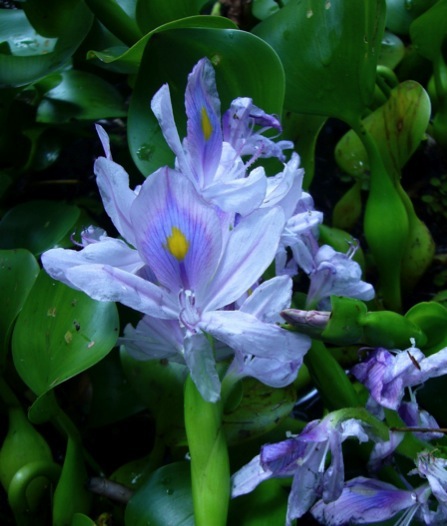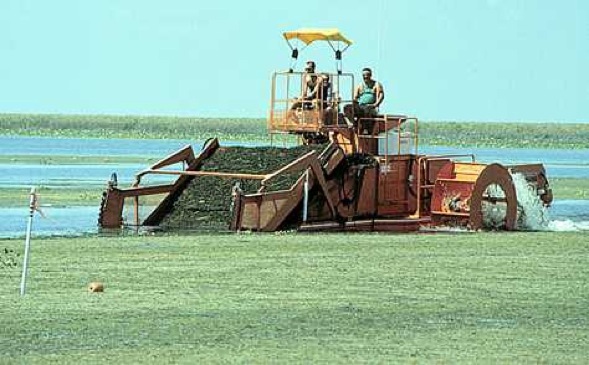
Water Hyacinth's blossoms always have a gold spot
Water Hyacinth Stir Fry
The state of Florida minces no words about the water hyacinth: “Eichhornia crassipes is one of the worst weeds in the world — aquatic or terrestrial.” They apparently have not tried them deep fried with butter, or steamed like mustard greens with a bit of bacon or pork fat.
Water Hyacinths, a member of the pickerelweed family, are born nearly pregnant adults. … Okay, that might be an exaggeration but they can double in population in as little as two weeks. One plant in one season can multiply to cover one acre. They caused a serious threat to Florida waterways not long ago and have only been fought to a constant draw. If the state were to stop fighting for one season the weed would get the permanent upper hand. In Panama, it would make the canal impassible in three years if not kept under control.
Of course, the other view is here is a plant that can feed you again in two weeks. That’s not a bad return if you’re starving or need green vegetables for a balanced diet. Even when viewed as an edible there are two down sides: While young leaves and stems can be eaten cooked or raw, raw they give quite a few people the itches, and cooked they still make a few people itch. So you have to sort that out before you eat too many. And very much like lichen, water hyacinths can absorb and hold just about any chemical pollutant around. Moral of the story, collect them from only clean waters. Never collect them down stream from any mine because mining can cause toxins. On the other hand, if I were selling hydroponics foods in a state that has a real winter to limit escape, this would be a plant I would experiment with: Fast growing, reproduces easily with about the same leaf texture of some seaweeds. The deep fried bottoms are more along the lines of deep fried pork rinds. Some writers say water hyacinth is tasteless but I have found when cooked to be close in texture and taste to a mild collard green. It always retains some “tooth.”

Clearing a lake of water hyacinths, temporarily
Water hyacinth originated in tropical South America, but is naturalized in warm areas of the world: Central America, California and southern states, Africa, India, Asia, Australia, and New Zealand, the latter where it is illegal so eat it fast. It was introduced to the United States in 1884 at an exposition in New Orleans. A Florida visitor to the exposition returned home with water hyacinth and subsequently released them into the St. Johns River. He later said the citizens of the state should thank him for what he did. The view now is they should have hanged him. While water hyacinth does not like winer temperatures it can be found in many protected spots in northern states such as Illinois, New Jersey, Connecticut, New York even adjoining Canada.
I suspect a lot of reported northern locations are aquariums. The plant is known as a natural oxygenator for fish and at the same time keeps the fish tank clean. If you keep a natural fish tank it makes sense. In the wild, opinions aside, it’s a breeding ground for many insects fish eat.
Water hyacinth is a good cattle fodder, chicken feed, mulch. dry fuel, mushroom growing medium, cigar wrappers, furniture and fertilizer. It is also a fantastic biomass for making alternative fuels. Florida should be thinking of water hyacinths as “green” oil, Florida Tea, a sustainable source of fuel. Instead, it’s a “weed” they don’t know what to do with. (See my 14 March 2008 blog.) The water hyacinth’s leaves are a source of vitamins A, B1 and B2 and betacarotene. They contain 18.7% protein, 17.1% fiber and 36.6% carbohydrates. Each year, the state of Florida spends some $15 million to control it. Some of that control is by spraying poisons, so be careful where you collect hyacinths. (See photo at bottom of page for mechanical means.)
Don’t confuse water hyacinth with Frog Bit, Limnobium spongia, which has similar looking leaves. The water hyacinth has black feathery roots and a bulbous float at the bottom of its stem. Floating Frog’s Bit has white roots, slender and ridged stems and no bulbous growth at the bottom of its stem. The water hyacinth also has runners to sister plants.
Its genus name, Eichhornia, (ike-HOR-nee-uh) honors once Prussian Minister of Education, Culture and Medicine, John Albert Friedrich Eichhorn. Crassipes krah-SEE-peez also KRASS-ih-peez) means thick foot, referring to the plant’s large, floating root mass.
Lastly, a law was passed in Florida to reduce the spread of this pant. It says: “It is illegal to collect, transport, possess or cultivate this plant (Rule 62C-52.011 FAC).” “But officer, I was only taking it home for supper….”
Green Deane’s “Itemized” Plant Profile
IDENTIFICATION: A floating aquatic herb, also rooting in mud, in dense mats with young plants attached to adults, submerge roots . Submersed roots feathery. Leaves in rosettes; stems spongy, usually inflated orbulbous near base; leaf roundish or broadly elliptic, glossy green. Flower a showy spike above rosette, lavender-blue, six petals, one with a yellow blotch. Fruit a three-celled capsule with many seeds. They can be dormant for as much as 30 years. Remember, the stalks are always bulbous and the flower has an orange spot on the upper lobe of the flower.
TIME OF YEAR: Year round in Florida, further north flowering in late summer, early fall.
ENVIRONMENT: A wide variety of wetland from lakes, streams, ponds, waterways, ditches, to backwater areas and factory discharges. It does not like brackish water. Make sure the water and area are wholesome.
METHOD OF PREPARATION: Leaves boiled or fried, young bulbous bottoms fried, flowers boiled or candied. All can still make some people itch after cooking, try cautiously.
HERB BLURB
Herbalists in India say juice from the water hyacinth is good for treating fresh wounds to keep them from infecting. The flowers have also been used to treat skin conditions on horses.
And the following are as published so you can read them and make up your own mind:
(The FASEB Journal. 2007;21:1724-1729.)
Novel rhythms of N1-acetyl-N2-formyl-5-methoxykynuramine and its precursor melatonin in water hyacinth: importance for phytoremediation N1-acetyl-N2-formyl- 5-methoxykynuramine (AMFK) is a major metabolite of melatonin in mammals. To investigate whether AFMK exists in plants, an aquatic plant, water hyacinth, was used. To achieve this, LC/MS/MS with a deuterated standard was employed. AFMK was identified in any plant for the first time. Both it and its precursor, melatonin, were rhythmic with peaks during the late light phase. These novel rhythms indicate that these molecules do not serve as the chemical signal of darkness as in animals but may relate to processes of photosynthesis or photoprotection. These possibilities are supported by higher production of melatonin and AFMK in plants grown in sunlight (10,000–15,000 µW/cm2) compared to those grown under artificial light (400–450 µW/cm2). Melatonin and AFMK, as potent free radical scavengers, may assist plants in coping with harsh environmental insults, including soil and water pollutants. High levels of melatonin and AFMK in water hyacinth may explain why this plant more easily tolerates environmental pollutants, including toxic chemicals and heavy metals and is successfully used in phytoremediation. These novel findings could lead to improvements in the phytoremediative capacity of plants by either stimulating endogenous melatonin synthesis or by adding melatonin to water/soil in which they are grown.—Dun-Xian Tan, Lucien C. Manchester, Paolo Di Mascio, Glaucia R. Martinez, Fernanda M. Prado, and Russel J. Reiter. Novel rhythms of N1-acetyl-N2-formyl-5-methoxykynuramine and its precursor melatonin in water hyacinth: importance for phytoremediation.
Potential of water hyacinth (Eicchornia crassipes) in ruminant nutrition in Tanzania: Abstract, Livestock Research for Rural Development, Volume 17, Number 8, August 2005
Two experiments were conducted to investigate the potential of water hyacinth (Eicchornia crassipes) in ruminant nutrition in Tanzania. In the first experiment , biomass yield, chemical composition, in vitro dry matter (IVDMD) and organic matter digestibility (IVOMD) and in-sacco degradability of water hyacinth were investigated. In the second experiment water hyacinth was ensiled using 0, 10 and 20% molasses levels as an additive, and subsequently analysed for dry matter (DM), water soluble carbohydrates (WSC), IVDMD and IVOMD.
Biomass yield (ton/ha/year) of water hyacinth was estimated as 322.2 tons (approx. 30.45 tons DM/ha/year at 9%-10% DM content) . Sun drying for 8 hours was adequate to wilt the fresh water hyacinth to a product of 15.35% DM, the chemical composition of which was 18%CP in leaves and in shoots. The whole plant showed significantly (P<0.001) lower DM digestibility (42.32%) compared to leaves and shoots (58.15 and 57.03%). No significant difference in dry matter digestibility was observed between leaves and shoots. Potential degradability was 68.09%, 60.82% and 52.91% for leaves, shoots and whole plant respectively. The rumen degradable fraction was 44.2%± 3.11 in the whole plant, 58.71%± 6.29 and 52.41%±1.38 in the leaves and shoots respectively.
Addition of 10% or 20% molasses to WH silage significantly (P<0.001) improved IVOMD from 42.15% in untreated silage to respectively 54.6 and 52.76% .Likewise the in-sacco DM degradability was improved from 48.53% in untreated silage to 54.76% and 54.55%. The Crude Protein (CP) content was significantly (P<0.001) lower for 10 and 20 % molasses treated silage (80.75 and 77.68 gkg-1DM respectively) compared to untreated silage (97.61 gkg-1DM.). It was concluded that water hyacinth could provide large quantities of nutritious feed to ruminants in the Lake zone.

